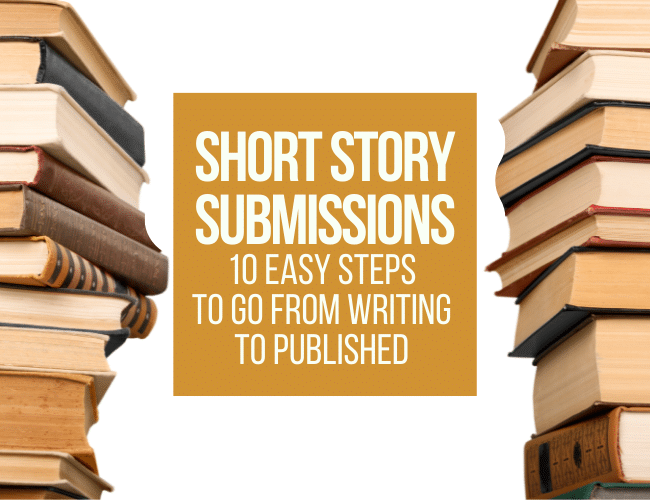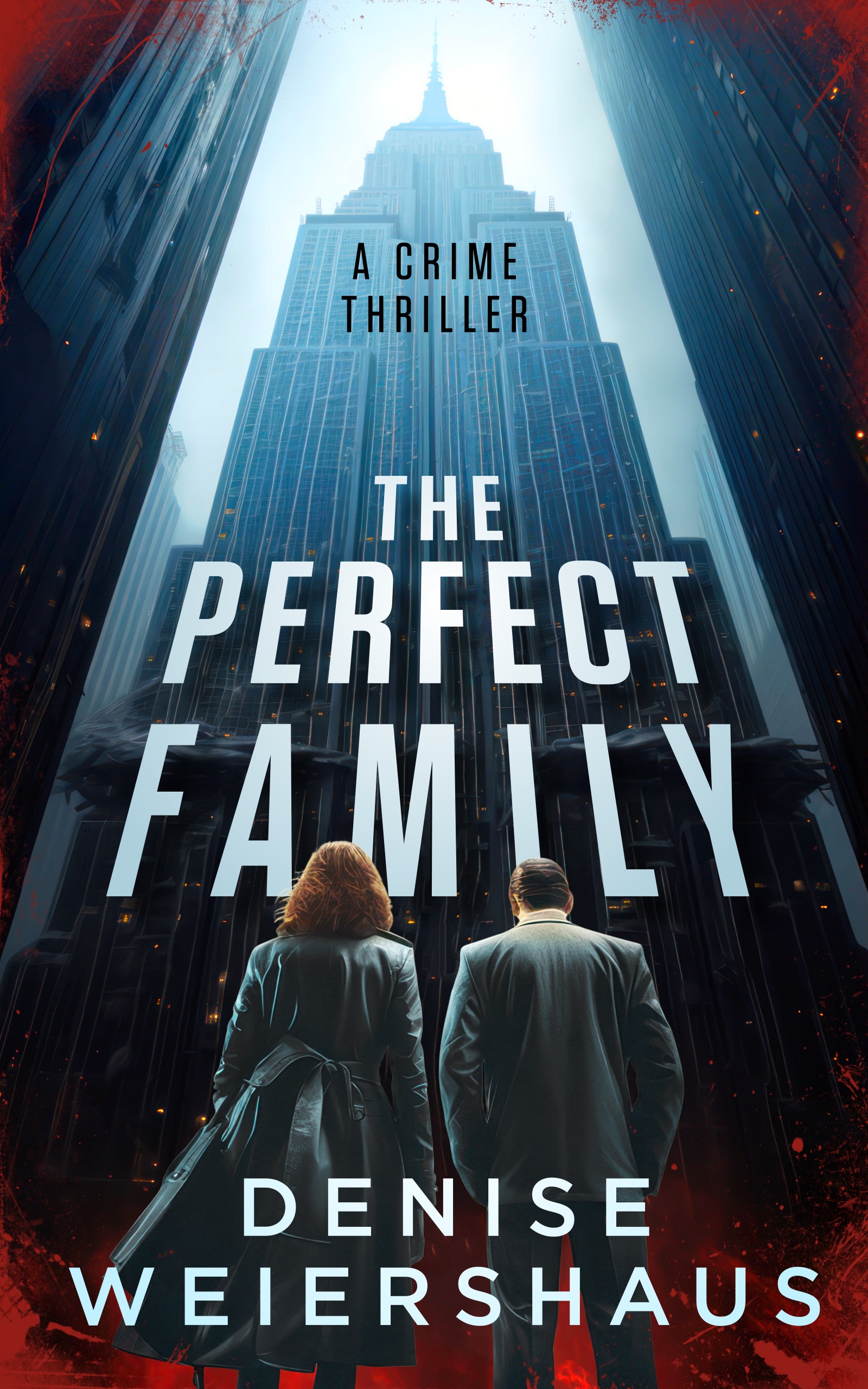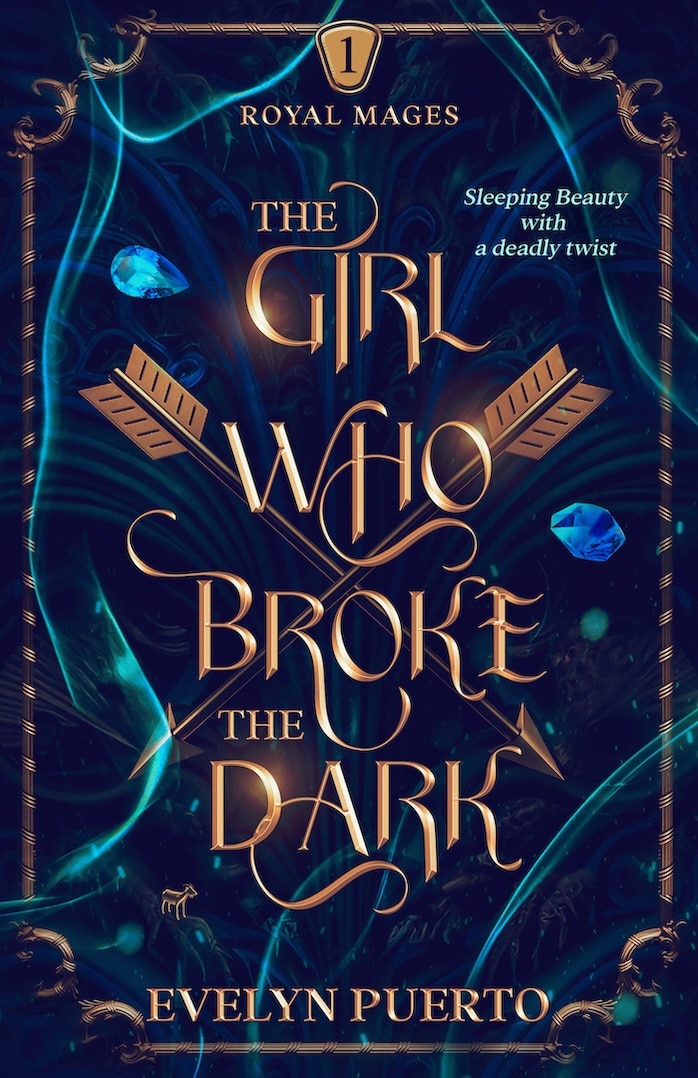How do you submit short stories for publication? It's a lot to think, about and I've seen more than one writer throw in the towel and say they're happy to just be writing. To make it easier, here are ten steps you can take to tackle short story submissions.

It may seem overwhelming, but once you know what you're doing, getting short stories published isn't as scary as it seems.
In this article, you'll learn the ten steps needed to submit a short story for submission and hopefully get it published.
The 10 Steps to Submit Your Short Story for Publication
If you're looking for a quick guide, here are the ten steps to follow in order to submit your short story for publication. Click each step to jump to more details.
- Read the guidelines.
- Pay attention to deadlines.
- Format your manuscript properly.
- Prepare a bio.
- Prepare an elevator pitch.
- Write a cover letter.
- Submit!
- Submit again.
- Record your submission.
- Wait.
Read on for a detailed explanation of how to master each step of the process and get your piece of short fiction published.
Writing to Getting Published: The Full Journey to Short Story Publication
I focus on fiction in this article, but the vast majority of this information applies to creative nonfiction writers and other nonfiction submissions like critical essays or book reviews. If you already have a story on hand to submit, jump down to learn exactly where and how to get it published.
But if you don't have a short story ready to publish, or if you want to write a new story specifically for publication, we've written a series of articles on how to write your best short story and maximize your chances of getting it published.
Here's the full process from idea to publication, with links to our articles about each step:
- Choose your publication. The best way to publish a short story is to choose a publication and then write a story for that publication. Why is this the best way? Because your story will already be tailored for a publication rather than a story that sort of fits. Stories that sort of fit have a lower likelihood of being accepted for publication. For more on how to choose your publication, read our guide to finding the best publications for you.
- Plan your story. Once you've chosen where you want to submit, it's time to plan the story. If you're stumped for writing ideas, check out our 100 Best Short Story Ideas, then read our guide for how to turn your idea into a brilliant short story plan.
- Write your first and second drafts. I always recommend writing the first draft of a short story in one sitting. It'll be more cohesive that way. Be sure to take a break between drafts so you can edit with fresh eyes! Here's how to write your story like a pro.
- Get feedback and edit your final draft. I can't stress how important getting feedback is to the writing process. You need to know whether your story makes sense or leaves the reader bored. And, trust me, you'll miss typos. Guaranteed. If you don't have a writing group to give you feedback, consider checking out The Write Practice Pro. And to help you make the most of your feedback, read our guide to editing your story.
- Submit! Read on for where to submit and the step-by-step process of submission.
5 Places to Publish Short Stories
The first step in publishing your short story is deciding where to publish. There are quite a few options to choose from when you're ready to publish your piece of short fiction:
1. Anthologies
Anthologies are short story collections by different authors, and most will take unsolicited submissions. (An unsolicited submission means they did not approach you; you are pitching to them.) They're often themed and either pay per word or a flat token payment. Some pay royalties, but this is rare.
When you publish in an anthology, you sell your publication rights to them for a specified period. (Note: This DOES NOT mean you sell copyright. Copyright is ALWAYS yours from the moment you pen the story. Never sell copyright to anyone.)
What this means is that you are not allowed to republish the story anywhere else until the agreed-upon time runs out. Then all rights revert back to you, and you may publish the story elsewhere as a reprint.
2. Literary magazines/literary fiction journals/online fiction journals
Literary magazines are publications that focus on creative writing. They aren't just for literary fiction. There are plenty of genre literary magazines out there, such as fantasy or science fiction literary magazines!
Lit mags can be printed or exist solely online (e-zines). They're normally published at least quarterly, but some are only yearly and some are published monthly.
Unfortunately, a lot of literary magazines aren't able to pay their contributors, or they pay in token payments (a one-time flat-rate, sometimes with additional copies of the magazine), or contributor copies, rather than paying royalties.
As with anthologies, you sell your publication rights to the magazine or online fiction journal for a specified period.
Check out our list of literary magazines to start your lit mag search. I recommend buying an upcoming issue if you can afford it to see exactly what they like and print.
3. Podcasts
Everyone loves a good podcast, and there are plenty out there that buy short stories. These podcasts are pretty cool. They take your story and produce it with sound effects and voice actors. Think old-time radio show.
4. Self-publication
Thanks to the internet, everyone is able to publish their own work. Amazon and Draft2Digital make it fairly easy to self-publish on all online retailers, as well as libraries. You can even make your story available in print through these companies.
The benefit here is that you get royalties each time you sell a copy. The downside is you're less likely to sell a ton of copies.
5. Your website
If you don't have an author website, you should strongly consider setting one up (here's how). You can share your releases there, build up an email list, and show up in a Google search. Sites are also a cool way to introduce your work to your readers with free stories.
How do you find places to publish your short story?
You can search for open calls for submissions for podcasts, literary magazines, and anthologies on sites like Duotrope, The Grinder, and Horror Tree. We also keep a list of our favorite literary magazines.
Make sure to follow writing groups on Facebook as well for more chances to submit.
How to Choose Where to Publish Your Short Story
Now that you know your options, how do you choose?
The answer depends on your goals for the story.
Do you want to share it with a select group of people? Are you wanting to build your email list or social following? Go with your website.
If you're wanting to move toward building a wider readership, you're going to want to go bigger. You'll want to look into anthologies, literary magazines, and podcasts. International submissions are great, too, if they're in the language your story is in.
If money is your main motivator, I'm going to tell you right now you'd better forget about that.
Most short fiction publications have little to no money to pay contributors. Some offer no monetary payment at all. It's up to you if you are okay with taking no monetary payment or a token payment.
Again, think about your goal.
Either way, you're not going to get rich publishing short stories. Even the publications that pay professional rates only normally pay up to eight cents a word. I've never seen more than ten cents a word offered.
And that's fine! Why? Because the point of publication is to build readership.
Watch out!
Fortunately, there are many reputable publications out there. Unfortunately, there are also disreputable ones.
Watch out for publications that charge a reading fee or submission fee. This warning doesn't apply to short story contests, where it often makes sense to charge a small fee in order to raise funds for prize money.
And I'm not saying all publications that charge a nominal submission fee (or reading fee) are evil; I just don't agree with them taking advantage of short story writers who desperately want to be published.
Also, be wary of publications that don't offer payment specifics. They might promise “professional rates,” but it's a bit weird to not specify what they consider a professional rate. Do some extra research in this situation to make sure they're a reputable publication.
How to Submit a Short Story for Publication: The Complete 10-Step Process
Once you've gotten your story polished to the shiniest it can be, you're ready to submit. But how do you go about doing it? What is the professional etiquette for submitting? What should you prepare before you email an editor?
Here are the steps to submitting a short story to a publication:
1. Read the guidelines
Ninety-nine percent of publications have guidelines posted on their websites. (These might be listed as submission requirements or writer guidelines rather than submission guidelines.)
If you're having trouble finding them, look harder. There will be a link to submission guidelines somewhere; it just might not be in the header menu bar. Check the bottom of the page if it's not in the header menu.
If you've been following this blog series, you most likely already read the writer guidelines when you chose your publication—but read them again.
Guidelines are extremely important, and you need to follow them. There are publications out there that will reject your story without reading it if you don't follow the rules.
If that sounds petty, it may be, but as someone who's edited anthologies before, I can tell you it's a huge pain if the author didn't follow instructions. And the last thing you want is to annoy the editor.
Remember, they get a huge volume of submissions from writers (I'm talking hundreds of submissions) every time they're open for a submission period. They don't have time to deal with an author who can't follow instructions.
Plus, it's rude, unprofessional, and shows a lack of enthusiasm for the publication to ignore the rules.
I repeat: Read the guidelines and follow them.
2. Pay attention to deadlines
Deadlines are there for a reason. They'll be listed on the publication's website, and you need to abide by them. Don't think you can sneak in a day late with an excuse. If you miss the deadline, you'll have to wait until the publication opens for another reading period or submit it elsewhere.
Pro tip: Write deadlines down on a calendar or use an app to keep track. You should keep track of these like you would a word deadline.
3. Format your manuscript properly
An improperly formatted manuscript is another annoyance for editors. Some publications will have specific formatting guidelines they want you to follow (again, check the submissions guidelines), but most will simply want your story in standard manuscript format (Shunn).
Shunn is the gold standard for manuscript formatting. Go to that link and read the entire document thoroughly! Here's a final checklist to make sure you have everything you need.
Some things to pay special attention to:
- DO NOT use tab or space to indent your paragraphs. You need to set up indents in your word processor (.5 inch is standard).
- Use a normal font. Times New Roman or Courier are preferred. Do not get fancy. Black, 12-point, double-spaced font is also standard.
- Margins should be 1 inch.
It makes it a lot easier if you format your stories in Shunn format as you write so you don't have to tweak them later.
4. Prepare a bio
You should always have an updated, short author bio ready to go. Bios are written in third person and are often required to be under one hundred words. (You may want to prepare two: one under fifty words and one under one hundred.)
If you have published stories in other publications, you can list them. Choose your three most recent or your three most prestigious. Don't list everything you've ever published, though.
If you don't have publications, don't worry! Just leave that part out.
Here's an example:
Sarah Gribble is the best-selling author of dozens of short stories that explore uncomfortable situations, basic fears, and the general awe and fascination of the unknown. She’s currently cooking up more ways to freak you out and working on a novel.
Follow her @sarahstypos on Twitter, @sarahgribblewriter on IG, or join her email list for free scares at sarah-gribble.com.
5. Prepare an elevator pitch
An elevator pitch is pretty much what it sounds like: a one- to two-sentence summary of your story (what you could get out in the time it takes to ride an elevator). You’ll also hear it called a premise, a summary, or a logline.
IMPORTANT: Not every publication will want this. In fact, most don’t. If they don’t specifically say they want a premise, short summary, elevator pitch, etc. in the guidelines, do not send them one.
I do recommend you prepare one at this stage, though. It’ll be easier later on when you’ve forgotten the exact point of your story and you need to have one. It’s also less stressful to have one prepared before submitting.
6. Write a cover letter
A cover letter is different from a query letter and is not nearly as daunting as it might seem. A cover letter is really just a few sentences introducing yourself and your story.
You don’t need to fill a page with several paragraphs. In fact, don’t do that! Editors don’t want to spend more time reading your cover letter than they do reading your story, and they don’t need to know what made you want to write or how many pets you have.
Here’s what you need in a cover letter:
- Salutation (Dear Editor is normally fine, but use the editor's name if it is on the website.)
- Story title and word count (Always include your word count. Even online publications only have so much space for stories, and your word count will be taken into account.)
- Optional: Elevator Pitch (Again, DO NOT do this unless the publication asks for it.)
- Your previous publication history (It's fine if you don't have any publication credits. Just skip this. DO NOT say you're a novice or this is your first story.)
- Thanks and sign
Here's an example:
Dear Editor,
Please consider my 1,800-word short story, “Story Title,” for publication in Random Magazine.
My writing has appeared in a variety of online and print publications, including Random Anthology I, Unusual Anthology Vol. II, and Titled Magazine.
Thank you for your time and consideration.
Sincerely,
Your Name
That’s it! See, not so bad.
7. Submit
The days of mailing a paper submission to literary journals and short story magazines are over. Most publications use electronic submissions now. The majority will take email submissions.
Some use other electronic submission systems, like a submission form on their site, an online portal, or a submission platform like Moksha, Hey Publisher, Duotrope, or Submittable. You’ll find where and how to submit your story in the publication’s submission guidelines.
Tip: It might be worth signing up for a submission platform like Duotrope. Some of them charge a membership fee, often because they have access to better calls for submission, but those fees are normally tiny.
If you're writing and submitting a ton of short stories and getting published frequently, it might make monetary sense to sign up.
Pay special attention to the submission guidelines. (I know I’m starting to sound like a broken record, but I can’t stress this enough.)
Paste your cover letter in the body of your email. Most likely, unless your story is a piece of flash or you’re submitting poems, you will attach your story to the email. This is the standard way to submit, but make sure that’s how your chosen publication wants it.
Make sure you take note of what kind of file the publication wants. Some are okay with a simple DOCX format, but some want an RTF. You can change how the file is saved in the SAVE AS menu.
Make sure your story is attached before sending the email! (Seems ridiculous, but I’ve sent emails without attachments several times.)
If the publication requires a “blind read,” make sure you don’t have any identifying information on the document.
Make sure you have the correct email subject line typed. (Guidelines, again.) If you don’t, it might get lost in a spam filter. If there are no specific guidelines regarding the email subject, go with: SUBMISSION — Your Story Title — Your Last Name.
Proofread your email!
After you’ve done all that, take a deep breath. It’s time.
Hit SEND!
8. Submit again
Hooray, you have a piece under consideration! But you're not going to sit on your laurels.
Check to see if your chosen publication allows simultaneous submissions. If they do, that means you can submit your story to other publications while you're waiting for a decision. [FYI: Multiple submissions allowed means the publication will take more than one story from you at once.]
I highly recommend submitting to as many publications as you can. The acceptance rate for anthologies and magazines is quite low, so you're increasing your odds of being published if you get that story out there to as many editors as possible!
9. Record your submission
You need to keep track of where you've submitted, when you submitted, when you expect to hear back, and what the response was.
There are online options for this, such as The Grinder, but you can use anything that makes you feel comfortable and that you'll keep accurate. A spreadsheet or notebook would be fine. I double up on my tracking and use a site as well as my own spreadsheet.
10. Wait
You'll most likely be waiting a while before you hear anything from the publication. This isn't a quick process, and it's often agonizing to wait for an answer, especially if you're new to the whole submission process.
Most publications will have their expected response time listed in their guidelines, but they're often late. Be patient. Their editorial team is sifting through hundreds of submissions.
Sometimes, if you submitted through an online portal, you can check the submission portal for an update on your piece.
Whatever you do, DO NOT email them to ask for an update (unless their guidelines say you may after a certain time). It's unprofessional to do so and won't earn you any points in the editor's eyes. All that does is clog up their inbox, and we all hate that.
How to Publish Your Short Story…and Actually Reach Readers
What's the point of publishing? To get your work read, of course!
But here's the thing: Publishing alone won't get you readers. You have to share your work!
No matter where you publish, it's your responsibility to promote your work. Editors won't do it. Big publishing houses won't do it (or won't do most of it).
You have to do it. You have to share your work with the world.
Once you've published, share your work on social media, on your website, in your newsletters. Talk about it around the water cooler and at family functions. Never shut up about your work!
That's how you get readers. You promote yourself, your publications, and your writing. (And it never hurts to help a fellow writer out by promoting their work as well!)
Publish, Publish, Publish!
Getting short stories published is a pretty simple process once you know what you're doing. (Way simpler than writing!) Getting your writing out there with short story publications is the best way to keep your work on your readers' minds.
If you get a few rejections along the way, don't give up! We all get them. It's part of the writing process.
And so is publishing.
So get your latest story polished and submit that baby to some publications! It's an amazing feeling to see your story in print!
Have you submitted a short story to a publication before? Let me know in the comments!
PRACTICE
Imagine a writer has submitted a short story to a prestigious literary magazine and has just received a rejection. The rejection was a personal note from the editor (which is rare!), explaining why the piece was turned down.
Write the post-rejection scene. Start out with what the editor said in the rejection email. Write for fifteen minutes.
Share your writing in the Pro Practice Workshop so we can all check it out. Don’t forget to read and comment on your fellow writers’ work!
Not a member yet? Join us here.
Happy writing!
Sarah Gribble is the author of dozens of short stories that explore uncomfortable situations, basic fears, and the general awe and fascination of the unknown. She just released Surviving Death, her first novel, and is currently working on her next book.
Follow her on Instagram or join her email list for free scares.




Thanks a lot! Very good information.